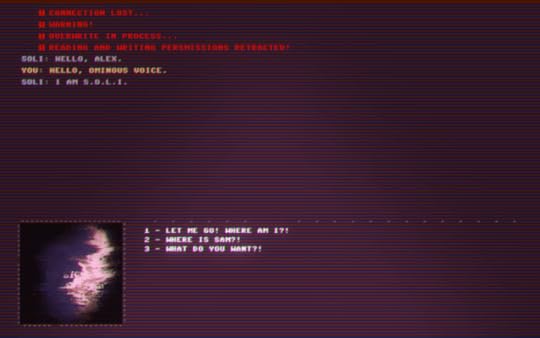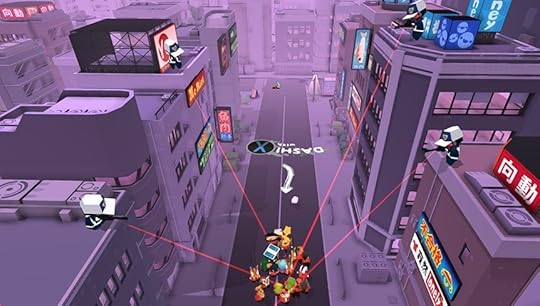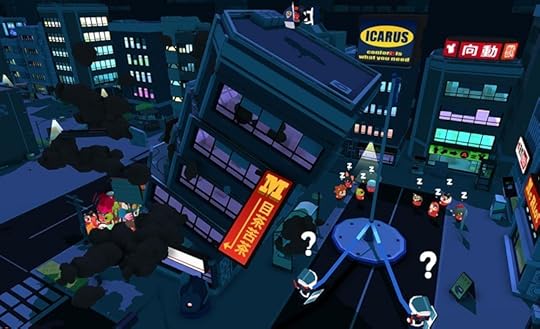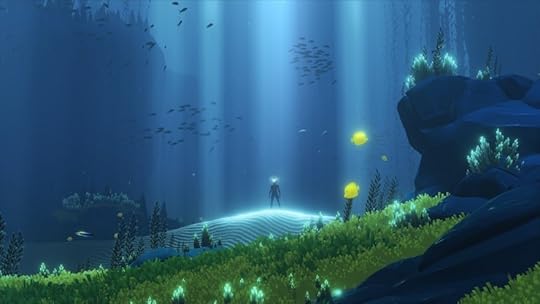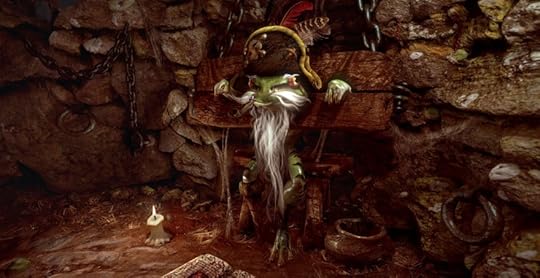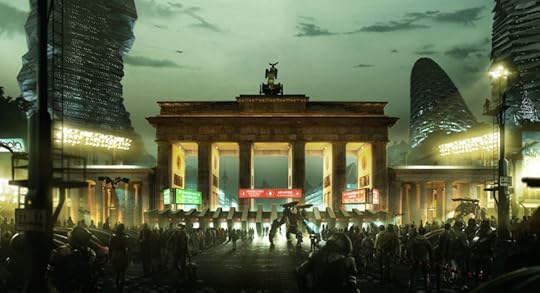Kill Screen Magazine's Blog, page 80
August 4, 2016
Code 7, a sci-fi text adventure that aims to inject fear into your mind
There’s a scene in Alien (1979) when Nostromo captain Arthur Dallas climbs into the ship’s tangled air ducts to seek out the Xenomorph on-board. The crew, looking on from a computer terminal, sees only two dots on a map—Dallas and the Xenomorph—until the tracking system malfunctions, and neither Dallas nor the crew have any clue how close or how far the alien is from him. Dallas waits in panicked silence while the rest of the team manages the glitch. All of a sudden, it’s too late.
Code 7 uses a similar approach to explore the terrifying nature of the unseen. In the text adventure, you’ll play as Alex, a hacker sent on a mysterious mission on-board an eerie space station. Your partner Sam has been separated from you after a disaster of some sort, though you’re still in contact with her via an on-ship communication interface. You’ll never actually see what’s happening to Sam; you’ll rely on what she’s relaying to you.
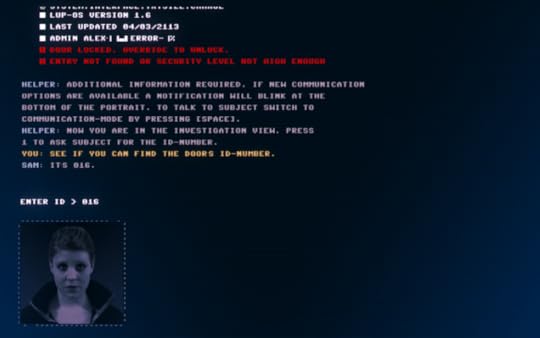
“The most terrifying things are those that you don’t see, but imagine,” Code 7 narrative designer and animator Zein Okko said. “We wanted to create a game where the horror plays in your head, and in your head alone.”
“our minds can create whole worlds just by reading a few words”
Input commands move the story forward. You’ll “hack” your way through a computer terminal, accessing different rooms as Sam moves her way through the environment. Text input is the core interaction here, but it’s part of the story, too—just like in Her Story.
You’ll likely never see what, exactly, has ravaged the ship you’re on; from what’s available in the game so far, your core view seems to be the computer terminal. Your imagination is creating your reality, and that’s what developers Okko and Kevin Glaap wanted. “We both love the fact that our minds can create whole worlds just by reading a few words,” Okko said. Code 7 is preying on human vulnerabilities and fears to reveal the suspicion and paranoia that lingers under the surface—the fear of the unknown.
Code 7 wants you to question reality, to question who you are and what makes you human. In this way, developer Goodwolf Studio draws inspiration from Doctor Who—and in particular, an episode called “Silence in the Library” (2008), where young girl’s consciousness is transplanted into a library’s operation system. Code 7 wants you to ask at what point a human mind is no longer, well, a human mind.
Goodwolf Studio will launch a Kickstarter campaign in September for Code 7, when Episode 0 will be released for free. For now, you can check out the trailer and devlog on the Code 7 website or on Steam. Episode 1 is expected to be released in February 2017 on PC, Mac, and Linux.
The post Code 7, a sci-fi text adventure that aims to inject fear into your mind appeared first on Kill Screen.
Not even Anarcute can put a friendly face on rioting
State of Emergency (2002) seemed real dumb even to a 14-year-old kid reading its EGM cover story. A chaser to Rockstar’s monumental Grand Theft Auto III (2001), State of Emergency wanted to carry on the torch, but only for Grand Theft Auto’s chaos and edginess. It was a Crazy Taxi (1999) for rioting where you’d play as thugged-out agents of mayhem, torching bystanders, smashing property, and maiming mall cops into pools of blood and floor tiles.
According to David Kushner’s book on Rockstar, Jacked (2012), a reporter from the Tacoma News Tribune called up Rockstar’s PR in May of 2001 to ask if the game was intentionally reminiscent of the Battle of Seattle—an anti-globalization protest only a few years prior in 1999. It was considered to be one of the largest American protests of its time. Drawing tens of thousands of demonstrators, it boiled over into a clash with intensified security, jailing hundreds of people, leaving millions in damages and the resignation of Seattle’s police chief Norm Stamper. Not meditating too much on the question, according to Kushner, Rockstar’s PR bounced a quick answer back to the Tribune reporter. “Yeah,” they said, “it probably does look like that.”
Controversy over sex and violence worked in Grand Theft Auto’s favor, but any comparison to real-world events did not fare well with State of Emergency. After other outlets ran with the open window that the game maybe sorta intentionally evoked the protests in Seattle, Rockstar found themselves backtracking their controversy. Sex sells, but you can’t sell anything if major retailers refuse to carry your “anarchy training” game. They discovered, much earlier than others, that as dumb as you may want to present your game and as much fun as property destruction is in a virtual setting (there are six monotonous Rampage games on more than a dozen platforms), it’s very difficult to divorce even the most reduced act of rioting from their history.
Anarcute is an exercise to see just how much distance from contention is possible. A game about property destruction, cop killing, and corgis, it—needless to say—hasn’t found itself with the most tactful launch window in videogame history.
The world of Anarcute is being invaded by an un-cute force. Authoritarian, gas masked, and similar to reality’s increasingly Jin-Roh’d police, these tiny tyrants are imprisoning animal buddies in ACME steel cages while occupying Tokyo, Paris, and other iconic metropoli. You start with a small, red-shirted crew before growing your revolution, freeing new revellers from their entrapment or just waking them up as they day dream in the alleys with big Zs above their sleepy lil’ heads. You win the world back, borough by borough, smashing the authority off the map.
As you grow, you gain more abilities, stomping the ground with a unified richter, lobbing whole cars and trucks at police barriers and even toppling over entire buildings to smoosh forces on the other side. There are traps, obstacles, and bosses. Engaging with enemies one-on-one is a moment of mitigation, as even the most basic foes will likely off some of your party. The controls feel a little fudgy, and watching my movement bleed doesn’t always feel justified to my actions. Typical.
the patronizing vibe of merely evoking the act of unpeaceful protest
It’s novel, colorful, and simple. If State of Emergency was the rioting answer to Crazy Taxi, then Anarcute is the rioting answer to Katamari Damacy (2004). But just like State of Emergency isn’t as captivating as a game about reckless driving to an Offspring song— Anarcute feels too basic to maintain momentum. Similar to Occupies before it, it starts to feel old, the point feels more distant, and you begin to wonder if the only reason you’ve kept at it is the catchy name. And that’s all an aside to just how itchy a game about glossy googly eyes on revolt is in general.
I have a tradition of reviewing games with impeccable timing. And so, here I am, writing a review of a genuinely mediocre game with schoolyard chanting and bunny wunnies holding up teeny tiny protest signs while a violent coup happens over in Turkey. We are, of course, also amid a tragically recaptivated response to lethal police violence on black Americans, and frustrating attacks on police officers by veterans—disillusioned men failed on two fronts. Games, especially the ones that aim to be cute, aspire to live in a different world, but you’re going to play them in the single one that you live in.
When I spoke to the team behind Splinter Cell: Blacklist (2013) about having a Benghazi level, they explained that when you make a game with a year-spanning development cycle set in international hotspots for espionage, odds are something bad is going to happen in at least one of them. This is a fair response. I might not have the answer for the patronizing vibe of merely evoking the act of unpeaceful protest in a game, but my gut is rumbly. I am fully aware that the creators of Anarcute had no bad intentions, just bad timing. And that sucks. Still, it riffs on the notion of protest turned riots in visual ways that don’t end up fun enough to leave a smile on my face.
RIOT, a long-dormant game that does explicitly seek to recreate international incidents in the same way Star Wars Battlefront wants to take you to fucking Endor or something, may come off as even more knuckleheaded than the game where puppies and kitties topple the state, but I’m willing to be proven wrong. Many games, largely, want to create mayhem where messages may also occur, while protests, largely, want to create messages where mayhem may also occur. Anarcute wants an adorable inferno. The joke is that the destruction is big but the perps are cutie wuties. But I don’t know if I have the planet to play it on.
For more about Kill Screen’s ratings system and review policy, click here.
The post Not even Anarcute can put a friendly face on rioting appeared first on Kill Screen.
Get dazzled by the watery depths of Abzû
Sign up to receive each week’s Playlist e-mail here!
Also check out our full, interactive Playlist section.
Abzû (Windows, PlayStation 4)
BY GIANT SQUID
Abzû is the next game by Matt Nava, who was previously the art director at thatgamecompany, most notably on Journey (2012). Nava and team trade desert sands for oceans and the many creatures that populate them in Abzû. It all started with a dreamy vision of scuba diving, and has since flowed into an underwater journey full of orchestrated highs and lows, of unknown depths and dangers, where you learn to admire and respect the fish all around you. You can meditate on rocks and watch the fish swim by, learning their scientific names and other details, but you can also join them, clinging to their fins for a ride. There is also magic here, not only residing in the totems and mystical architecture found amid the corals, but in how you repopulate the waters, diving in and out of a dreamland made of icons. Your work makes the waters swim with more and more colors but you continue to dive down, toward the black of the abyss.
Perfect for: Merpeople, marine biologists, scuba divers
Playtime: 60-90 minutes
The post Get dazzled by the watery depths of Abzû appeared first on Kill Screen.
August 3, 2016
Inside The Void explores isolation horror on an alien planet
Inside The Void evokes a similar sense of isolation horror as Solaris (1972) or Event Horizon (1997). Both films place their protagonists on rescue missions; neither of which sound all too promising for the rescue crew—and both of which quickly descend into a series of mysteries and hallucinations.
Several crews of researchers have already been dispatched to Inside The Void’s remote alien planet. All have gone missing, though they’ve left little notes—log entries—on their findings. Many of them are grim; they speak of being transported to endless voids through seven alien structures on the planet, of unsuccessful attempts to reach the structures’ cores. Besides looking at occasional log entries placed around the low-poly environment, players simply wander—there are no creatures, just structures. The real goal is to simply hold onto reality, and maybe save those missing crew members.
a void that imitates an unending LSD trip
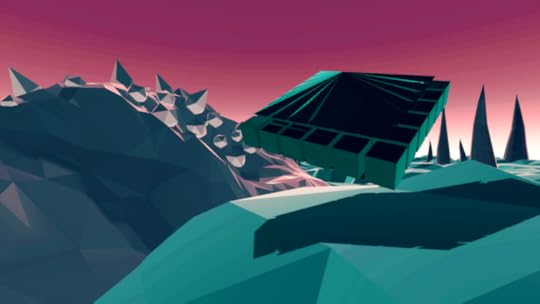
The voids are like vaporwave fever dreams: each has a jarring atmospheric change that differentiates itself from the original alien planet. Creator Jacob Medina likens it to surrealist PlayStation videogame LSD: Dream Emulator (1998); a videogame inspired by artist Hiroko Nishikawa’s eccentric, decade-long dream journal. (By the way, Nishikawa has a lot of wacky dreams worth checking out, my favorite of which is when Niskikawa compares plugging data into a shrunken human’s butt to identifying the sex of a baby chick.)
Being alone on the alien planet is surprisingly spooky. Being transported to a void that imitates an unending LSD trip is even spookier. Having films like Solaris and Event Horizon in the back of one’s mind conjures up the terrifying possibilities of staying in a place like Inside The Void’s alien planet for too long. The eerie music helps, too.
Inside The Void was released July 28 by 3D Methods. It’s available for free on itch.io. Medina’s games and artwork are also available on the 3D Methods website.
The post Inside The Void explores isolation horror on an alien planet appeared first on Kill Screen.
Inside is coming to PS4 after all
We are very fond of Playdead’s Inside, the Danish designers’ follow-up to 2010’s Limbo. It’s bolder, more gut-wrenching, and alive.
Until today it was only available on Xbox One and PC, which means most of you probably played it on PC. But Playdead have just announced that on August 23rd, Inside is coming to PS4! That is very soon.
Inside‘s arrival on The People’s Console hopefully means a resurgence in attention, sort of like how Hyper Light Drifter‘s debut on PS4 meant exposure to a whole new audience. You should play this game. I suspect, come December, it’ll be sitting high up on Kill Screen’s best-of-2016 list. Just sayin’.
The post Inside is coming to PS4 after all appeared first on Kill Screen.
Tooth & Tail brings out the animals of historical warfare
Pocketwatch Games, the studio that brought us bungling co-op heist game Monaco (2013), is back with Tooth & Tail, an arcade-style strategy game based on the Russian Revolution. While still deep in the development stages with Tooth & Tail, the studio does have a video that shows how matches are able to play out in under 20 minutes (pretty quick for a strategy game). The trailer is truly a teaser of what is to come, with a few shots of a battle between mice carrying contrasting colored flags and tearing down the castles of their enemies.
As the title alludes to, Tooth & Tail has you controlling a mice faction of up to seven units or structures that must destroy the other faction to avoid being eaten. Yes, you heard that right. “Food is a natural currency in an animal world, and so the events of Tooth and Tail are all built around meat and starvation,” said Andy Schatz, the developer behind the game. “Tooth and Tail‘s revolution is driven by factions that differ on who gets to eat and who must be dinner.
The brutality of the animal world is often blurred with the human world
Tooth & Tail was directly inspired by classic real-time strategy games like Command and Conquer (1995), but it comes with a simplicity that mirrors competitive chess rather than, say, an expansive experience like Company of Heroes (2006). The controls, which are meant to be played with a gamepad over a keyboard and mouse, fit the usual adage—easy to learn, but difficult to master. Schatz said that this design was to help bring in a broad variety of players to the strategic genre while still delivering an entertaining brain burner.
Beyond that, there are certain historical parallels with the game to consider. As World War I began creeping up on the Russian Revolution, food became the most valuable resource. Supply was either non-existent or too expensive for the average citizen to purchase, especially in St. Petersburg, the capital. On top of that, farmers would often hoard food for their own use. The brutality of the animal world is often blurred with the human world during times of war. This is put on display in Tooth and Tail, where food is the No. 1 thing on your faction’s mind, even if it means death.
Interestingly, Tooth & Tail has already built a community before the game has been released. With a Discord channel, multiple tournaments and an active Twitch stream, you can already see plenty of buzz building around the game.
Find out more about Tooth & Tail on its website.
The post Tooth & Tail brings out the animals of historical warfare appeared first on Kill Screen.
Exit Flatland
This article appears in Issue 9 of Kill Screen’s print magazine. It launches on August 8th, but you can get 10 percent off before that date with the discount code RELAUNCH.
///
In 1884, Edwin Abbott Abbott published Flatland: A Romance of Many Dimensions. It was told from the perspective of A Square, who lives in a 2D world. His life is transformed by the entrance of A Sphere, who opens his eyes to the existence of a third dimension.
For millennia, Western painting and architectural rendering occupied flatland. For all the joys of medieval art, perspective was often distorted, with large, compressed figures and buildings. With the discovery of the vanishing point, depth in Renaissance religious allegories and ideal cities became possible. Yet there were limitations. Buildings and figures behind the immediate street-level view were obscured; art remained a frozen moment.
Centuries later, programmers faced a similar problem. Lacking the technical capabilities for convincing 3D games beyond skeletal vector graphics, a flatland perspective was adopted in everything from Pac-Man (1980) to Castlevania (1986). Ingenuity went into the character of games, but they were still rendered as glorified floor plans.
As it had for architects, the breakthrough came in axonometry’s most common form—isometric projection. Where the lines in linear perspective converged at a vanishing point, here they travelled vertically and 30 degrees to the left and right. This enabled a tilted bird’s-eye view onto objects, with three sides showing rather than one. Squares became cubes. Facades became buildings with volume. It was both revealed truth and mirage.
“Space games explode into a new dimension,” boasted the flyer for Zaxxon (1982), and games soon revelled in the geometric possibilities. In titles like Marble Madness (1984) and Highway Encounter (1985), you piloted 3D shapes around the terrain. In Ant Attack (1983), the star was not a giant insect but the pixelated Brutalism of the environment. Its city was called Antescher after the artist M.C. Escher, whose work (particularly his 1938 lithograph Cycle) had influenced another isometric hit of the time: Q*bert (1982). Escher had embraced the possibilities of axonometry for disorienting optical illusions, hinting at later physics-defying games like Gravity Rush (2012), Fez (2012), and Monument Valley (2014).
to gaze down upon entire metropolises
The history of game development is partly one of turning weaknesses into strengths. The Stamper brothers’ Filmation engine connected individual isometric rooms through archways; they created a template for fantasy in Knight Lore (1984), space travel in Alien 8 (1985), and the supernatural in Pentagram (1986). When processing power finally allowed it, it was possible to gaze down upon entire metropolises, enabling city-building games from Populous (1989) to SimCity (1989). All architects harbor fantasies of demolition, and in the likes of Desert Strike (1992) and Command and Conquer (1995), players could lay waste to architecture and its inhabitants. Death was not even necessarily the end, with Afterlife (1996) enabling the creation of isometric heavens and hells.
Axonometry changed the nature of interactive storytelling in videogames. The ability to move around cities and interact with multiple characters—rather than simply repel invaders or pick off sentries—was crucial to the development of RPGs like Baldur’s Gate (1998). You could get drunk in a medieval castle (Ultima 8), assassinate insubordinate politicians (Syndicate), or play roulette in an irradiated wasteland (Fallout). You could even step inside a replica of Umberto Eco’s The Name of the Rose (1980) in La Abadía del Crimen (1987). Despite (or because of) the mastering of “real” 3D, axonometry remains popular, as evidenced by Transistor (2014), Satellite Reign (2015), and Bastion (2011). Beyond nostalgia, it suggests we might be voyeuristic gods, rather than one of those tiny sprites.
In the 1980s, System 3’s best-selling The Last Ninja series evoked a semi-mythic Japan, with Buddhist shrines, rock gardens, and seppuku-committing guards. Its isometric perspective was crucial to its sense of exploration. The player climbed walls and descended into dungeons. Dragons emerged from grottos and birds flew through Torii gates.
There was a strange sense of déjà vu playing The Last Ninja. Its environment was recognizable because we had seen it before, long ago. In a mix of propaganda and pageantry, Chinese court painters had been employed to commemorate imperial festivities. These were expected not only to celebrate the grandeur of the kingdom but to record events as they happened. This fourth dimension of time was captured on scrolls like Along the River During the Qingming Festival by Zhang Zeduan and Xu Yang’s The Qianlong Emperor’s Southern Inspection Tour. To enable this widescreen view, they developed axonometry.
The masters of ukiyo-e woodblock prints borrowed the method, with the screens and sliding panels of Japanese architecture allowing artists to pry inside teahouses, brothels, and pavilions. Gazing at the original scrolls, it’s tempting to imagine the characters moving around the cityscapes. This was partly the intention. Like cinema, the basis for videogames was already there, centuries before our imaginations became powered by electricity. We discovered the future in a foreign past.
Subscribe to Kill Screen’s print magazine for many more articles like this one.
The post Exit Flatland appeared first on Kill Screen.
Go on a mousey adventure brought to life by a DreamWorks animator
There’s something classically European about animal heroes. It’s why Ghost of a Tale looks and feels classical in the first place. From Aesop’s Fables to the golden age of Disney animation, cute and brave animals have been at the center of heroic adventure stories. Ghost of a Tale asks the player to become that animal hero.
“It’s a dangerous world out there for a little mouse…” begins the game’s trailer. The third-person adventure game has the player navigating a dangerous medieval island as Tilo the mouse, who has been imprisoned there by the rats. The shadowy atmosphere is a purposeful callback to games like Ico (2001) and Dark Souls (2011), as well as old Disney films like Sleeping Beauty (1959) and The Black Cauldron (1985).
“charm and mystery rather than violence”
The game, and its animation especially, is beautiful. Which is no surprise given that its creator, Lionel Gallat, has a long history with famous animation studios. He worked as an animation director at Universal before committing to Ghost of a Tale, but he got his start at DreamWorks as an animator on films like The Prince of Egypt (1998) and The Road to El Dorado (2000).
His decision to turn away from this career and go learn how to code came from a “growing dissatisfaction with not seeing enough games with AAA visuals that did not involve slaughtering hordes of enemies,” he told me. He started with experiments into creating small islands and rigging the animated models he was used to mocking up so that he could control them as in a videogame. Once he had an alpha version of the game ready, Gallat took to Indiegogo back in 2013 and successfully raised the funds required to continue work on the game.
Now, after a few more years of work, Ghost of a Tale is finally in its Early Access phase, which Gallat says is about “30 percent” of the final game. While the full game will feature even more varied environments, anthropomorphic characters, ghostly enemies, and quests, the game already features classic adventure game staples such as puzzles and stealth.
“I wanted to do something that appeals to [the] player through its charm and mystery rather than violence, to elicit a sense of wonder I felt as a kid when playing some games in the 80 and 90s,” Gallat said. Judging by the Early Access experience, Ghost of a Tale‘s strength lies in the living, breathing world imagined up by Gallat, brought to life with over a decade of professional animation film skills.
You can purchase Ghost of a Tale on Steam Early Access and GOG. You can also find out more about it on its website.
The post Go on a mousey adventure brought to life by a DreamWorks animator appeared first on Kill Screen.
The Milano Games Festival aims for thoughtful discussion around videogames
A big part of playing videogames is doing so collaboratively. We like to talk about and share our experiences. Before now, arcades were the place to go for this, where you could gather around arcade cabinets, watching your peers smashing high-scores and giving commentary as you wait for your chance to play. But now it’s mostly online, with livestreaming services letting thousands of people gather around a single game-playing session, all shouting into the chat.
Seizing on this kind of behavior—albeit hoping to foster more thoughtful discussion—and coming hot on the heels of film festivals like Cannes, Sundance, and Toronto, is the Milano Games Festival. It’s a new event that will stretch over five evenings in September, and aims to give people a space to play, appreciate, and discuss unique games with a like-minded crowd.
“it’s never been tried before”
“We wanted to find a place for games that do not display well or otherwise fit in traditional game events,” said Pietro Righi Riva, one of the organizers of the festival “‘Arcade’-like settings are not suited to more immersive, longer-term games that require concentration. On top of that we wanted a space that provided an opportunity to share an experience and discuss it (like in a film festival) and for that to happen in games it was necessary that all participants play the same game.”
It’s not a new idea, but it’s a long way from the traditional methods that current events and venues often use to showcase games. A typical evening at the Milano games festival will start with guests having 30 minutes to sit down and play with the as-yet-unannounced game shorts that will be at the event. After that allotted time, there will be a brief presentation to introduce the main game of the evening and explain how to control the game and how it will play. Then the game will start across all 30 stations, each equipped with one controller and two sets of headphones, with each attendee free to bring a guest.
If attendees get stuck or have any questions, they can raise their hand and get assistance from the event staff. When they’ve finished the game, or after two hours, guests will head upstairs for a Q&A and drinks. There will be two sessions an evening, and for each evening there will be a different game. The five games this year are ABZÛ, Gorogoa, Night in the Woods, Future Unfolding, and The Town of Light. Righi Riva said the games were chosen to fit a specific format: easy to play, no previous “gaming” experience required, two to three hours in length, and with a heavy focus on narrative and/or exploration.
“[What’s exciting to me] is that it’s never been tried before,” Righi Riva said, “it has the potential to attract people that are not normally interested in games. Particularly, people that think that games cannot contribute to culture, or do not fit in their taste for culture.”
The Milano Game Festival will run as part of the XXI Triennale. Screenings run every night from 6-9 and 9-12 between 8-12 September at via Carlo Bo 7 in Milan. See the website for more details.
The post The Milano Games Festival aims for thoughtful discussion around videogames appeared first on Kill Screen.
“Augs Lives Matter”: The hollow race politics of the new Deus Ex
In anticipation of Deus Ex: Mankind Divided’s release later this August, Square Enix and Eidos Montreal have released a series of pictures depicting the current state of major cities around the globe during the events of the game, including London, Berlin, Barcelona, Rio de Janeiro, and Moscow. They are… certainly something.
As far as art goes, it is at least technically admirable: it hits the exact grimy spot between “this is too normal to obviously be a dystopia” and “I had to stop playing to go take a bath,” and the cities look big and bustling and appropriately futuristic. The skies are nice and smoggy—except for Brazil, because if you ask someone not from Brazil to draw you Brazil they’re gonna hand you an in-flight advertisement—and in every picture large compounds are bursting out of the ground like ugly, architecturally unsound flowers. It does create a distinct feel for the world, with that vibe, you know? The ‘I’m gonna get carpal tunnel from holding down the crouch button’ vibe.

But look closer at the pictures, and in the midst of this ambiguously gray future/dystopia/hellscape, something more interesting emerges. A huge component of the Deus Ex games is the presence of “augmented” humans, who are outfitted with a whole deal of robotic gizmos and genetic alterations and look like Cyborg from Teen Titans. At the end of Deus Ex: Human Revolution (2011), augmented people were implanted with biochips, which were triggered with a Big Red Button signal that made them go bonkers. Tons of people were killed, public outcry was enormous, and perception of the augmented went from “kinda weird robo-neighbors” to “haha, hell no.” By the time of Mankind Divided, augmented people have been cordoned off into slums—which are clearly visible in most of the pictures—and are treated as second-class citizens by the “normal” populace.
the execution is lacking both subtlety and consideration for the real issues it appropriates
I can believe that, at its heart, this is a genuine attempt to tackle the issue of discrimination, segregation, what have you, but from this distance it seems the execution is lacking both subtlety and consideration for the real issues it appropriates. The most egregious offenders are the “AUGS LIVES MATTER” signs found in the Paris, Sydney, and Moscow art, which obviously borrows wording and intent from the Black Lives Matter movement that gained traction in the United States after multiple shootings of unarmed black men by police. Which, you know, I understand the intent, but the difference should be self-evident. One is a videogame with a right to explore sensitive issues, but also an obligation to be respectful of the way those issues affect people in real life. The other is 156 black people killed by the US police in 2016 already.
It’s not that sci-fi and fantasy don’t have a history of using metaphor and fiction to explore societal problems, but in this instance especially, it rings hollow. If it’s an exercise in sympathy, try turning on the news. If it’s an attempt to convince people that discriminatory violence is bad, maybe talk to your mean uncle who calls the Civil War the “War of Northern Aggression” about the people who are actually being extrajudicially executed every day. There is a time and place for commentary on political issues; disaster porn in a background image is probably not it. Not only does it ignore those for whom this is an everyday concern, but it’s disrespectful to Trayvon Martin, Mike Brown, Sandra Bland, Philando Castile, and the hundreds of others who were killed without due process or legal justice because of a broken system.
This is all without confronting the dubious use of “apartheid” to refer to the division of augmented people from the rest of society, a term with heavy connotations in South African history, or the questionable choice to place a wall of checkpoints in front of the Brandenburg gate, because that doesn’t bring up any bad memories at all. There’s always a chance that Mankind Divided will pull this off, but unfortunately the pattern’s veering towards the downside; we’ll see if mechanical discrimination is treated with enough candor and grace to justify bringing up such raw memories.
See what Deus Ex has done to your city on its website .
The post “Augs Lives Matter”: The hollow race politics of the new Deus Ex appeared first on Kill Screen.
Kill Screen Magazine's Blog
- Kill Screen Magazine's profile
- 4 followers



